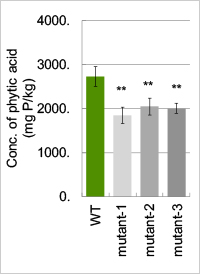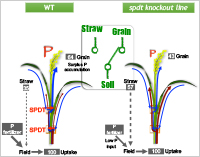Effect of knockout of SPDT gene on phytic acid concentration in rice grains
Enlarge Image Figure 2
Rice grains of wild-type rice and spdt mutant
Enlarge Image Figure 3
A scheme for the role of SPDT transporter in distribution of phosphorus in rice node
Enlarge Image
Reducing phosphorus in rice grain for sustainable and environmental-friendly agriculture
Application of phosphorus fertilizers is necessary to sustain high crop production in modern agriculture. Research has shown that the most of the phosphorus absorbed by the roots is finally allocated to the grains, which remove large part of phosphorus in soil at harvest. Phosphorus in cereal grains is stored in the form of a chemical named phytic acid, however, this form cannot be digested by human and most animals, resulting in excretion of phytic acid to the environment, which causes water pollution or ‘eutrophication’. Furthermore, phytic acid forms a strong complex with zinc and iron, which will decrease the availability of these metals. Therefore, reducing phosphorus accumulation in grains is an urgent demand for sustainable and environmental-friendly agriculture.
Jian Feng Ma of Okayama University and colleagues report a possible solution to this dilemma by controlling the flow of phosphorus into grain. Specifically, the researchers identified a phosphorus transporter (SPDT) that acts as a switch at the rice nodes, which is a hub for distribution of mineral elements. SPDT is a novel transporter identified so far. Importantly, Ma and his colleagues found that knockout of this gene can reduce phytic acid concentration in the grains by 20% without yield penalty. By contrast, more P was delivered to the straw, which will increase soil phosphorus by returning them to soils.
This strategy found in rice may be also available in other cereal crops. The researchers are confident that this approach to recycling of phosphorus and reduction in eutrophication of water will be an important factor for sustainable and environmental-friendly agriculture in future.
Reference:
Naoki Yamaji1*, Yuma Takemoto1*, Takaaki Miyaji2, Namiki Mitani-Ueno1, Kaoru T. Yoshida3 and Jian Feng Ma1*, Reducing phosphorus accumulation in rice grains with an impaired transporter in the node, Nature 541, 92, January 2017.
doi:10.1038/nature20610
- Institute of Plant Science and Resources, Okayama University, Chuo 2-20-1, Kurashiki 710-0046, Japan.
- Advanced Science Research Center, Okayama University, Okayama 700-8530, Japan.
- Graduate School of Agricultural and Life Sciences, The University of Tokyo, Bunkyo-ku, Tokyo 113-8657, Japan.
Corresponding author:
E-mail address: maj@rib.okayama-u.ac.jp (Jian Feng Ma).
Reference (Okayama Univ. e-Bulletin): Professor Jian Feng Ma’s team
・Vol.17 Professor Jian Feng Ma receives the 2016 Corresponding Membership Award from the American Society of Plant Biologists (ASPB)
http://www.okayama-u.ac.jp/user/kouhou/ebulletin/news/vol17/news_001.html
・Vol.16 Professors Jian Feng Ma and Naoki Yamaji receive “Highly Cited Researchers 2015” Award
http://www.okayama-u.ac.jp/user/kouhou/ebulletin/news/vol16/news_001.html
・Vol.13 Preferential distribution of silicon to rice grains
http://www.okayama-u.ac.jp/user/kouhou/ebulletin/research_highlights/vol13/highlights_001.html
・Vol.12 Plants feel stress!
http://www.okayama-u.ac.jp/user/kouhou/ebulletin/feature/vol12/feature_001.html
・Vol.11 Vitamin C transport in plants: AtPHT4;4 required for photo-inhibiti on tolerance
http://www.okayama-u.ac.jp/user/kouhou/ebulletin/research_highlights/vol11/highlights_001.html
・Vol.9 Arsenic toxicity: Reducing accumulation in rice grains
http://www.okayama-u.ac.jp/user/kouhou/ebulletin/research_highlights/vol9/highlights_004.html
・Vol.5 How rice plants deal with environmental changes in manganese
http://www.okayama-u.ac.jp/user/kouhou/ebulletin/research_highlights/vol5/highlights_002.html
・Vol.1 Identification of a rice transporter for manganese and cadmium uptake
http://www.okayama-u.ac.jp/user/kouhou/ebulletin/research_highlights/vol1/highlights_003.html



